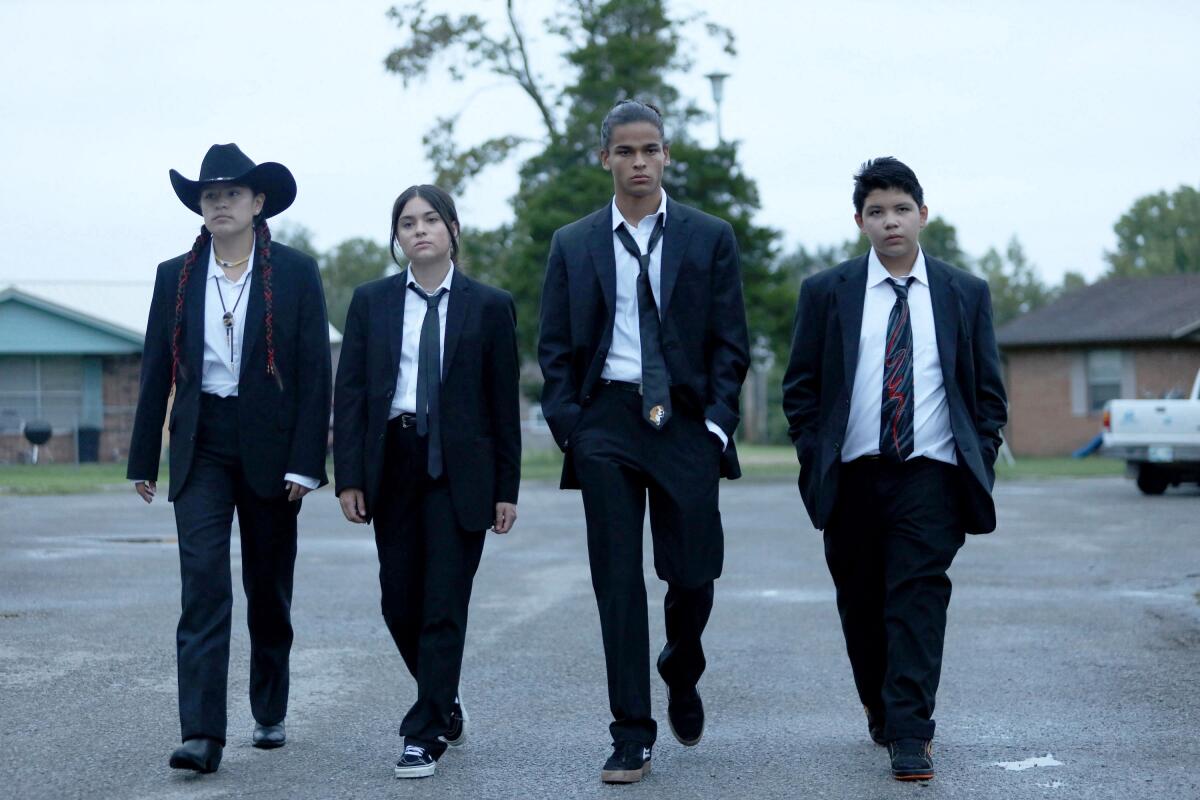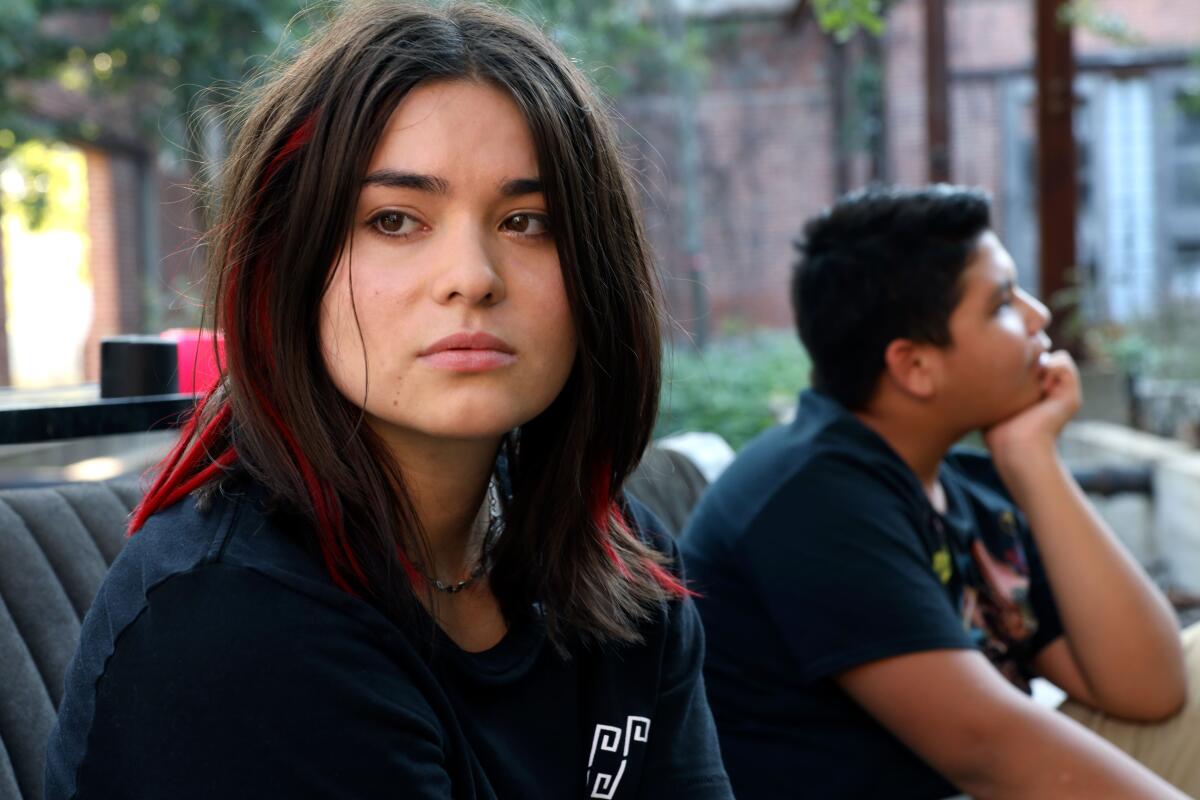What makes ‘Reservation Dogs’ the most radical teen show on TV

- Share via
There is a famous Hollywood story, from the 1920s, in which art director Cedric Gibbons went to MGM production chief Irving Thalberg to protest that a scene set in Paris called for a moonlit ocean in the background in a city with no ocean. “We can’t cater to a handful of people who know Paris,” Thalberg said. The ocean stayed.
I think we can agree that Paris is better — or, at any rate, more Paris — without the ocean.
Being a San Fernando Valley boy whose grandparents came to America as children from what is now the Ukraine around the turn of the last century, I am certainly not qualified to say whether “Reservation Dogs,” streaming on FX on Hulu, paints an accurate picture of life, or a slice of it, on and around the tribal lands of the Muscogee (Creek) Nation in Eastern Oklahoma, here referred to simply as “Indian territory.” I have traveled in that neck of the woods (and fields) and can only say that, yes, that is what it looks like — and that this show, in which four tribal teens steal things and sell meat pies to raise the money to go to California to avoid the fate of a dead friend, is charming, funny and a little bit beautiful.
Peacock’s “Rutherford Falls” stars Ed Helms as a good man with a big blind spot: He believes history is to be celebrated rather than examined.
But Sterlin Harjo (“Four Sheets to the Wind”), who co-created the series with Taika Waititi (“Jojo Rabbit,” “What We Do in the Shadows”), and directed select episodes, is a member of the Seminole Nation with Muscogee ancestry and grew up in Holdenville, Okla., about 60 miles southwest of Okmulgee where the series was largely filmed. (Waititi, from New Zealand, is Maori on his father’s side — different country, similar dynamic.) As the old advice goes, he is writing what he knows.
“Reservation Dogs” presents its world as both culturally distinct and completely ordinary, giving equal weight to each quality. Local references are understood by the characters, and viewers with some experience or knowledge of the place, without explanation for the uninitiated. This mix of the foreign and familiar is what draws us to films and series from other places, to characters whose lives may differ in custom and culture but not in greater human meaning. In considering what makes us different, we can get a bead on how we’re the same.

Although Native Americans, including those who consider themselves biracial, make up about 3% of the population — even in Okmulgee, the seat of the Muscogee (Creek) tribal nation, only about one in seven citizens are Indigenous — they have loomed large in the (white) national imagination. They have been at the heart of American mythologies and iconography since before the states were united, in portraits and artifacts from Wild West shows to western movies ( and revisionist western movies); Sacagawea to Sitting Bull; football teams to cigar store carvings; the YMCA’s Indian Guides (now called Adventure Guides) to hippies in tepees. To be able to claim a drop of Indian blood is generally a source of pride; the ironies there are too obvious to state.
Yet TV tends to flatten details of tradition, ethnicity, class and religion (or lack of it). It might leave them out in the name of ecumenicism, of inoffensiveness, of being something for as many people as possible — what an uncharitable person might call the lowest common denominator. It might be what the budget allows. It might be a lack of interest, or talent.
But without real specificity, you can wind up with clichés, stereotyped characters who unnaturally dominate the world into which they’re placed, rather than being shaped by it and having to navigate it. For the most part, “Reservation Dogs” allows its characters to float within their world without telling you what to think about it, or them. They are likable, but they don’t stand for anything other than their individual selves; they are not intended to display “aspects” of Indian culture, which is within them, but not all they are. (Some non-Indigenous characters do seem constructed to make a point, comically, about the ways in which Indigenous people view them.)
New Mexico’s Tesuque Tribe has opened Camel Rock Studios in response to Native Americans being ‘misrepresented and marginalized’ in entertainment.
Without it being programmatic, the four leads in “Reservation Dogs” have distinct personalities within the group, like the Beatles in “A Hard Day’s Night,” even as they mesh magnetically into a unit. There’s Bear (D’Pharaoh Woon-A-Tai), sensitive; Elora Danan Postoak (Devery Jacobs, who also has a recurring role in Peacock’s “Rutherford Falls,” the year’s other comedy with a Native American focus), determined, and named for a character in “Willow,” a film more discussed here than anything by Quentin Tarantino; Willie Jack (Paulina Alexis), tough, caustic, but will text with her mom in the middle of a caper; and Cheese (Lane Factor), comical, unconventional. “My name’s Cheese. My pronouns are he, him and his,” he’ll announce out of nowhere to a yard full of minor criminals.
Unlike many if not most TV teens, they seem genuinely unformed — works in progress. Their California project is both grand and entirely lacking in particulars. On a lesser show, they’d be precocious and focused and their criminal exploits would be complicated and heart-stopping rather than ramshackle in execution. There would be at least one love triangle. None would be wondering, as Bear does, “Maybe we’re the bad guys here.”
This in itself feels radical. Except for a brief flashback picturing a bad experience with stolen edibles, in the four episodes out for review, our heroes indulge in none of the activities traditional to 21st century TV teens: They don’t drink or do drugs or have sex, or even talk about it; they are too intent on doing what they need to do or think they need to do, to get out of town. They’re a self-contained misfit squad.

But what most distinguishes them from other TV teens, perhaps, is how they relate to adults. In many series built around young characters, parents are disposable except as dispensers of food and shelter; the kids otherwise take care of themselves. Grownups, consumed by their own messy business, are unreliable. There is a bit of generational mutual incomprehension among the characters in “Reservation Dogs” and light mocking of policeman Big (Zahn McClarnon), a Barney Fife sort with a penchant for the paranoid and the paranormal. Yet overall the younger characters treat the older with respect, or at any rate with indulgence. When a bedridden old woman in a clinic mistakes Cheese for her grandson, he hesitates only a second before playing the part and spends the afternoon with her. Bear puts money into his mother’s empty wallet.
The producers might have found someplace in Canada to make this show (many in its cast come from there), but every story is set somewhere and we are long past the age when the same Hollywood backlot street and square could stand for a dozen different locales. The closer you can be to where you say you are, the better. “Sex and the City” or “30 Rock” or “Gossip Girl” would lose a layer of meaning if the streets its characters walked in were those of Toronto dressed up with a sprinkling of yellow cabs and American flags; “Mare of Easttown” incidentally created a cottage industry in think pieces and social media debates over how well the series and star did or didn’t represent its scrap of Pennsylvania. But that it tried to mattered; it may be a small thing to have learned the meaning of Wawa, but what’s local enlarges the world, while what’s homogeneous diminishes it.
The problem with “Gossip Girl,” premiering Thursday on HBO Max, isn’t that it’s “woke.” It’s that it’s lost the original’s sense of humor.
Photographed by Christian Sprenger, who brought similar sensitivity to his work on “Atlanta,” another finely detailed series, the show creates a real sense of place, and space, an everyday world into which dreams and visions sometimes intrude in a workaday way. In a marvelous comic turn, Dallas Goldtooth (a member alongside Harjo of the Native American sketch comedy group the 1491s) plays a wandering spirit, a self-described “unknown warrior” who died at Little Big Horn before even getting to the fight, when his horse tripped in a gopher hole and rolled over on him. But it also does well in airless institutional settings. The second episode is set largely in a health clinic and featured Jana Schmieding (who stars in “Rutherford Falls”) as an unhelpful receptionist.
Outsiders will have to trust that Harjo and Waititi have made something true to the subject — something about which even insiders may disagree. Art habitually heightens, elides, romanticizes, demonizes, cheats and lies to get what it wants, but we tend to believe it when the art, as here, is good. It’s difficult to tell where a long arc might be heading, and “nowhere in particular” would not be the worst answer. To be sure, things could get plot-heavy, or bow to textbook notions of the well-made screenplay. The protagonists’ main problem comes in the form of some new kids in town (from “the city”) who seem intent on defining them as a rival gang, which could blow up into something “dramatic.” But it doesn’t need to — there is life in every frame.
‘Reservation Dogs’
Where: Hulu
When: Any time
Rating: TV-MA (may be unsuitable for children younger than 17)
More to Read
The complete guide to home viewing
Get Screen Gab for everything about the TV shows and streaming movies everyone’s talking about.
You may occasionally receive promotional content from the Los Angeles Times.







